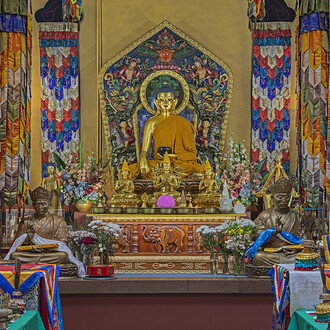Erarta Museum of Contemporary Art presents an exhibition by Anton Bratykin whose calm and desolate landscapes embody disquieting reflections on human dealings with reality.
True eulogies of the icy wastelands born out of field work.
More than 20 paintings created in collaboration with the forces of nature.
Visions of a bleak, uninviting, cold and windswept world emerging as chromatically impeccable and harmoniously arranged compositions.
Anton Bratykin’s calm and desolate landscapes embody disquieting reflections on human dealings with reality. The choice of scenery is noticeably grim, be it a night-time get-together in a garden plot between a dusty chair and a bathtub filled with rainwater or a heap of plastic bags lost amid sparse birch trees and containing something that appears to be either garbage or fallen leaves. The few people pictured are either roaming deserted snow-clad beaches or trampling through snowdrifts and thorny bushes towards some forbidding-looking narrow river. The visions that emerge are of a bleak, uninviting, cold, and windswept world.
Although lacking in vibrant hues and standout contrasts, these paintings are nonetheless chromatically and texturally complex. One almost expects them to take the cue from the bare tree branches and prickly snowflakes and start stinging the viewer’s eyes. With their harmoniously tuned palette and carefully arranged composition, Anton Bratykin’s canvases are true eulogies of the icy wastelands, and it certainly makes sense that they are born out of field work.
By turns alone and in the company of like-minded friends, the artist takes part in something that can be described as extreme plein-airs. Whereas other painters inertly follow the more than two-century-old tradition of heading straight for sunny Italy, Anton Bratykin stumbles with his pochade box across the frozen city-fringe waste grounds, finding particular pleasure in collaborating with the forces of nature, which either sprinkle his palette with small hail or sometimes even try to carry away some especially fine sketch with a sudden gust of wind.
All this stands in stark contrast to the currently popular hedonistic meditative practices in which the key creative impulse comes from bodily comfort. This kind of ‘being in the moment,’ however, feels much more acute and vivid. The chill, the babbling of a rusty stream, and the pale sunbeam on a bare birch trunk make up the unassuming set of impressions that can be arranged into a harmonious composition conjuring a dormant world that leaves no place for the human presence.
Anton Bratykin’s paintings are akin to ‘windows on another world,’ but, instead of demonstrating rugged mountainscapes or rampant waves, they focus on the familiar borderline states of nature, at times disastrous or at least simply unpleasant, like for example a sleet shower. Completely submerging himself in them, the artist resurfaces with a sense of joyous anticipation of spring, daybreak, and life’s continuity, sharing these precious finds with the viewer.
















